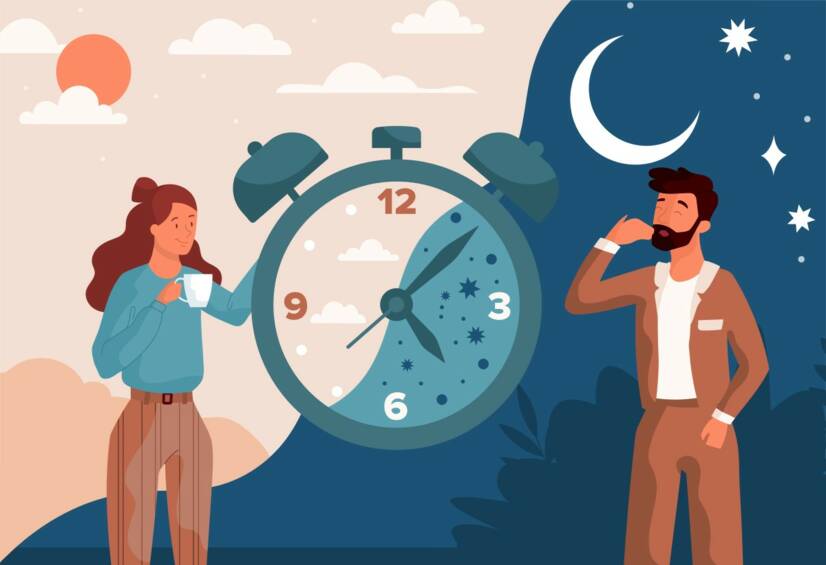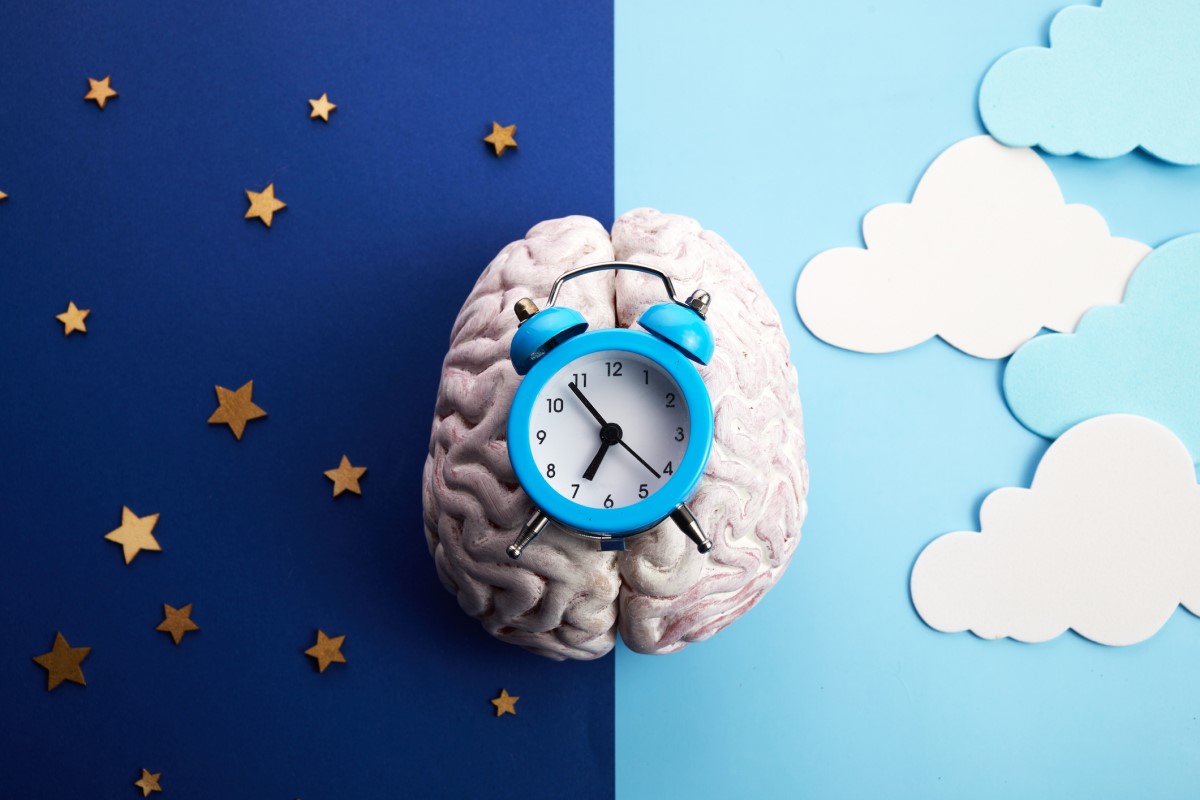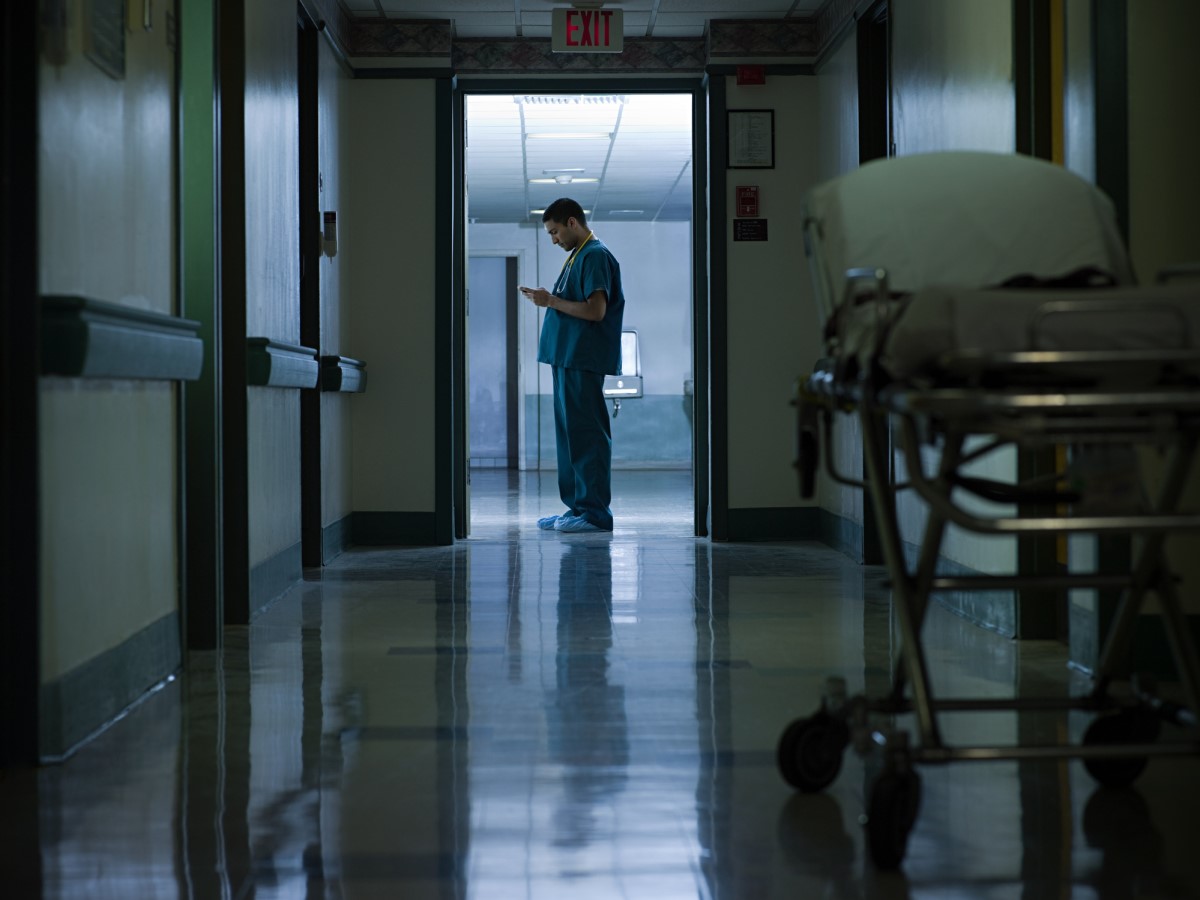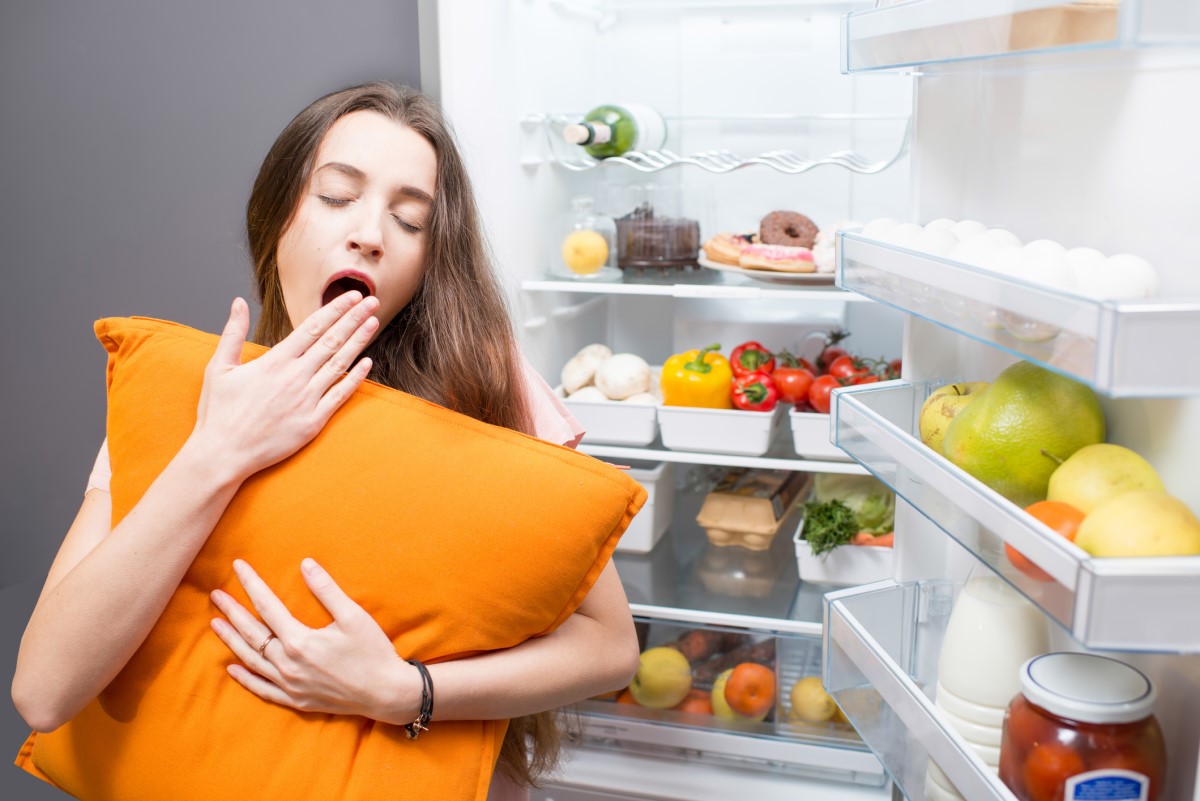- my.clevelandclinic.org - Circadian Rhythm Sleep Disorders
- webmd.com - Sleep Disorders: Circadian Rhythm Disorder
- rarediseases.org - Non-24-Hour Sleep-Wake Disorder
- upjs.sk - Biorhythms
- fns.uniba.sk - Circadian Rhythms, Prof. RNDr. Michal Zeman, DrSc.
- solen.sk - Neurobiology of circadian rhythms and clinical applications, MUDr. Pavel Černák, PhD., Philippa Pinel Psychiatric Hospital, Pezinok
What is circadian rhythm and biological clock? + Disorders and 16 foods to help you sleep better

Photo source: Getty images
What is the internal biological clock or circadian rhythm? What is related to this concept and what does it mean for our daily life?
Article content
- What is the circadian rhythm?
- Where does our internal clock reside and how does it work?
- Other hormones affecting circadian rhythms
- When is the healthiest time for our bodies to go to sleep?
- Age-related changes in biorhythms
- The circadian rhythm also controls the manifestations of some diseases.
- Circadian rhythm disorders
- Medical options for the treatment of sleep disorders
- Home tips on how to manage a shifted circadian rhythm
The internal biological clock or circadian rhythm - where does it reside and what influences it?
Changes related to age?
The connection between time of day and diseases.
Internal rhythm disorders and how to manage them at home?
Read on to find out the most important things.
In 2017, three American scientists (Jeffrey C. Hall, Michael Rosbash and Michael W. Young) were awarded the Nobel Prize in Physiology or Medicine for their unique research on the internal biological clock.
They brought much new information about the regulation of this biological clock at the cellular level, clarified its importance for human health and laid the foundations for the emergence of a new scientific discipline, circadian biology.
What is the circadian rhythm?
The alternation of day and night, or light and darkness, caused by the rotation of the Earth on its axis has existed since the beginning of living things. All organisms have adapted to these changes during evolution by developing biological rhythms.
According to the length of the period, biorhythms are divided into several types:
- Circadian rhythm - the length of the period is 24 ± 4 hours.
- Ultradian rhythm - period length is longer than 24 hours
- Infradian rhythm - with a period of less than 24 hours
- Circoseptal rhythm - their period is 7 (± 3) days
- Circadian rhythm - with a period of approximately 1 year (± 2 months)
Circadian rhythm is defined as the spontaneous regulation of the body in response to changes in the external environment. It allows the body to prepare for conditions that are yet to occur.
Just as a student knows what time a lecture will end, when an exam will be given, or what time the evening news will be on TV, the body anticipates changes. It prepares for them and is thus better able to cope with them.
In addition to the regular rhythm of day and night, there are other biorhythms in our body, such as the rhythm of body temperature, sleep, food intake, heart rate, blood pressure, hormone secretion, etc.
If these biorhythms are synchronous with the external environment, we are more efficient, we are in a better mood, our organs function better, our immune system functions better and we are more resistant to various diseases, especially civilization diseases.
Where does our internal clock reside and how does it work?
Every clock has a movement, the heart of the whole mechanism.
In the case of the internal clock, this functional unit resides in the brain, in a centre called the suprachiasmatic nuclei, located in the hypothalamus.
This centre maintains the biological rhythms even in the absence of external stimuli. It is a so-called pacemaker that works at the level of the genes.
In maintaining the circadian rhythm of alternating wakefulness and sleep, the internal clock responds based on the alternation of light and darkness.
When there is light outside, light rays hit the retina of the eye. Nerves from the retina transmit information about the light to the suprachiasmatic nuclei in the hypothalamus. This information is then fed to the pineal gland, which secretes small amounts of the sleep hormone melatonin.
The latter reaches its receptors (melatonin receptors) again in the suprachiasmatic nucleus, where it inhibits further production. This ensures minimal melatonin secretion during the daytime hours.
In the dark, melatonin is secreted in large quantities because it is not blocked by anything.
Its secretion starts at dusk and reaches its maximum level of secretion around midnight. In the morning it decreases again.
Melatonin has many biological effects in our body. This is due to the fact that melatonin receptors are located on various organs of the body, which react to the secretion of melatonin by changing their function.
As an example, here are some of the effects of melatonin:
- kick-starting the immune system
- positive development of the reproductive organs
- improving fertility
- affects memory and learning
- antioxidant effects

Other hormones affecting circadian rhythms
Cortisol, the most important and vital stress hormone secreted by the adrenal glands, is also secreted according to circadian biorhythms. Its concentration varies throughout the day.
We have the highest amount of cortisol in our blood in the morning after waking up, around 8 o'clock.
Sleeping at this time can suppress the natural peak of cortisol secretion.
Conversely, in the evening at the time of sleep, its concentration is lowest.
Interrupted sleep and frequent night wakings can be caused by excessive cortisol secretion during sleep.
Another hormone subject to circadian rhythm is growth hormone secreted by the pituitary gland. Its secretion is directly linked to the wake-sleep cycle.
Growth hormone is secreted most intensely during the deepest phase of sleep, the so-called slow-wave phase.
Frequent awakenings and interruptions of this sleep phase can negatively affect growth hormone secretion.
Prolactin is another hormone secreted by the pituitary gland, the hypothalamus. Its secretion is also directly related to the sleep biorhythm. Prolactin begins to be secreted about an hour after falling asleep and reaches its highest concentration shortly before waking.
Sexual luteinizing hormone begins to be secreted in children during sleep before the onset of puberty. This is used to identify the onset of puberty in children before visible secondary sexual characteristics such as increased pubic hair.
When is the healthiest time for our bodies to go to sleep?
Sleep is extremely important for the body. During sleep, the organs begin detoxifying, important hormones are secreted that keep our bodies in balance, the brain makes new neural connections and stores all new information.
Therefore, sleep deserves our attention and a little "programming".
In addition to the circadian rhythms described above, there is another important biorhythm of our body, and that is its body temperature.
Our body temperature is at its lowest between 3 a.m. and 5 a.m. After that, the temperature gradually rises and then drops slightly again 12 hours later. After this drop, the body temperature rises again towards evening before dropping again in the morning.
The healthiest sleep begins about 5 to 7 hours before the morning temperature minimum. This suggests that it is healthiest for the body to go to sleep before 10 pm.
In addition to falling asleep, the time of rising is of course also important. This should be 2 hours after the temperature minimum, i.e. no later than 7am.
The rate of falling asleep and maintaining sleep is influenced by the aforementioned hormone melatonin. Its secretion from the pineal gland is blocked by intense blue light, especially when it is naturally dark outside.
If you want to fall asleep quickly and soundly, you should not look at brightly lit mobile phone screens or television before going to bed, and you should have dim lighting in your home.
Instead of staring at a screen, read a book before bed. The light from a reading lamp is more natural and better for your eyes.
On the other hand, morning lighting is welcome and early blocking of melatonin can kick-start and refresh the brain faster.

Age-related changes in biorhythms
Humans do not have a "set clock" from birth, but this process evolves and changes with age. This is mainly related to the change in the secretion of the main sleep hormone melatonin.
Newborns do not have a circadian rhythm.
For this reason, their biorhythm is irregular and it takes several months for them to adapt to the external environment. Melatonin itself begins to be secreted at three months of age.
After a certain period of time, all functions and biorhythms adapt to the external environment and a regular sleep cycle begins. Children need up to 9-10 hours of sleep per day, preferably at night.
Although adolescents already have a fully developed circadian rhythm, there is a shift in their circadian rhythm. It is called "delayed sleep phase". In practice, this means that adolescents get tired much later than younger individuals.
They feel the most tired around 3 a.m. to 7 a.m. It makes sense that they need to sleep longer in the morning. The amount of sleep does not change and they still need the ideal 9 hours of undisturbed sleep.
This fact can help you be more accommodating to your teenage children who fall asleep late and are most tired in the morning when they have to go to school.
Adults should have a stable circadian rhythm.
However, maintaining regularity in habits and good sleep hygiene is important for its proper function.
Adults have their deepest sleep before midnight, after melatonin has been eliminated.
Paradoxically, they feel the most tired at a completely different time, between one and three o'clock in the afternoon. This is when the lull occurs.
If you opt for a small nap, it is allowed, but only for a short period of time, ideally 45-60 minutes. Later hours or longer naps are not recommended.
In older people, the circadian rhythm shifts again, in the opposite direction to puberty. They go to bed much earlier and also get up earlier.
The circadian rhythm also controls the manifestations of some diseases.
Doctors have noticed in the past that the occurrence of certain diseases is more frequent at certain times of the day.
For example, people with arterial hypertension have much higher blood pressure in the morning upon waking than at other times of the day.
Read also:
- Measuring blood pressure, pulse or breathing at home. How to know the values?
- Measuring blood pressure.
- What is masked hypertension? Normal blood pressure at the doctor, but...
- Untreated hypertension threatens health and life. What are its complications?
The peak incidence of epileptic seizures is early in the morning and late in the evening before midnight.
Migraine attacks occur especially in the morning, as well as allergic rhinitis or joint pain in rheumatoid arthritis.
Cardiovascular diseases have their time before noon. Angina, myocardial infarction or sudden stroke have their highest incidence at this time.
In the afternoon, diseases of the digestive tract appear, especially ulcerative disease of the stomach or duodenum is reported.
Skin diseases, dermatoses, eczema, itching, etc. tend to worsen towards the evening.
Also very unpleasant are chronic pains or tumour pains, which reach a maximum at night and wake up from sleep.
Circadian rhythm disorders
The most common types of circadian rhythm disorders in sleep include the following...
Delayed sleep phase disorder
In this type of sleep-wake rhythm disorder, you experience fatigue and cravings for sleep much later than other people in your environment. Your sleep and subsequent wake-up is delayed by at least two hours than what is considered a normal biorhythm setting.
Such people are often referred to as "night owls" because they have no need to go to sleep and stay awake until morning, for example, 2:00 am.
However, their need for sleep does not change from other individuals and they sleep until midday. If they have to get up early for work in the morning, they are perpetually tired, inattentive and sleepy. Such people are often perceived as lazy, unmotivated and lacking effort.
They are late for school, work or meetings in the morning, which does not leave a good impression.
In contrast, late in the evening and at night they feel most productive and creative, more attentive and efficient.
This disorder can run in families, so you may have inherited it from your parents, for example.
Advanced sleep rhythm disorder
People with this disorder are known for falling asleep too early, often while watching TV. They are also sleepy at social events and at work, which lingers into the evening hours.
Conversely, they wake up early, often in the middle of the night or early in the morning when everyone else is still asleep, around 2 a.m. to 5 a.m. They usually fail to fall back asleep despite their best efforts.
Such early rising is unpleasant. These individuals often complain of insomnia, although if we count their hours of sleep we find that they sleep as long as other people.
This type of disorder occurs mainly in middle-aged and elderly people and may also be hereditary.
Jet lag
One of the most well-known transient sleep disorders, suffered by people who have traveled by air across more than two time zones from their home. The disruption of circadian rhythms and internal clocks makes it significantly more difficult to acclimate and function in the new time zone.
Sometimes jet lag does not manifest itself on vacation, but only after returning home.
This is due to the fact that the holiday destination may have been in the west of the globe. Western countries are generally easier to travel to in terms of biorhythms, as it is easier to stay awake despite being tired than to fall asleep when you are not tired.
During the time spent on holiday, your internal clock has naturally adjusted. At home, however, you are already travelling eastwards, and that's when jet lag can kick in in full force at home.
In addition to fatigue and drowsiness, jet lag also manifests itself in other symptoms such as lack of appetite, upset stomach, diarrhea or constipation, mood disturbances and irritability.
Disruption of the biorhythm of shift work
This is a sleep disorder suffered by people who have to work in shifts. At times when it is dark outside and the body is naturally programmed to sleep, these individuals have to perform at maximum capacity and stay awake.
Most commonly, this includes medical workers, emergency workers, firefighters, food workers, workers in the technology industry, and others.
Moreover, this is not a regular night job. Usually, these employees alternate night and day shifts, so their circadian rhythm is constantly changing and cannot settle on a regular rhythm.
In addition to suffering from constant fatigue, these people may also experience more serious symptoms, such as:
- indigestion
- lack of appetite or obesity
- nausea
- stomach ulcers
- bowel disease
- cardiovascular disease
- headaches
- neurological disorders
- irritability
- anxiety
- mood disorders and depression
- increased risk of cancer, e.g. breast cancer
More serious health and social problems include increased risk of alcohol abuse and dependence.
Substances often abused include addictive substances such as various stimulants and drugs.

Irregular sleep-wake rhythms
This sleep disorder is characterized by not having a well-defined sleep-wake cycle. A person suffering from this disorder must nap several times during a 24-hour period.
Although he or she sleeps frequently, such an individual suffers from significant chronic insomnia and fatigue.
This disorder is most common in people with serious neurological diseases such as various degenerative diseases, dementia, elderly people living in nursing homes, children with intellectual disabilities and people who have suffered a head injury with brain injury.
Disruption of the 24-hour sleep-wake rhythm
People with this type of sleep disorder have normal sleep duration, but their "internal clock" is longer than 24 hours.
This causes the actual sleep-wake cycle to change from day to day, and to be delayed by one to two hours each day. This disorder is typical of blind people who lack light stimulus to the retina.
Medical options for the treatment of sleep disorders
Treatment for sleep disorders and circadian rhythm disorders is tailored depending on the type of disorder and its severity.
A combination of several therapeutic methods and discipline in the home environment is usually necessary for a positive treatment effect.
Bright light therapy
Bright light application therapy is used to facilitate falling asleep or to delay sleep. The most important and difficult part is the correct timing of this therapy, and therefore it should be administered by a sleep disorder specialist at a sleep center.
Bright light therapy involves the application of very bright, high-intensity light (2,000 to 9,500 lux). Exposure times range from one to two hours.
This realigns the circadian clock to better synchronize with the external light-dark cycle.
Medicines
The most common and readily available medication, even without a prescription, is melatonin, which is available in both spray and tablet form. It is taken shortly before bedtime and should help with falling asleep and staying asleep.
For more serious sleep disorders, a specialist doctor, such as a psychiatrist or neurologist, will intervene and prescribe the necessary medication depending on the type of disorder.
Chronotherapy
This type of therapeutic approach is based on gradually shifting or delaying (e.g. by three hours every two days) sleep time.
It is a relatively demanding process and requires patience not only on the part of the patient, but also on the part of his or her partner, if any. A successful shift in the sleep cycle may occur only after several weeks of diligent effort.
Once the cycle has been adjusted to a satisfactory rhythm, this regular sleep-wake schedule must be maintained over the long term.
Home tips on how to manage a shifted circadian rhythm
We can quickly help ourselves to a good quality and healthy sleep by changing our lifestyle and including a few foods that promote falling asleep.
Sleep hygiene habits include:
- Keeping a regular bedtime and wake time, even on days off, weekends and holidays
- limiting daytime sleep (not applicable to shift workers)
- regular physical exercise, but avoiding exercise for at least 1 hour before bedtime
- limiting alcohol before bedtime (although it is well known that a glass of wine or beer helps to fall asleep, sleep is not of good quality and is impaired by alcohol metabolism)
- not ingesting caffeine and nicotine before bedtime
- not viewing blue light screens, such as mobile phone or computer screens
10 foods that naturally contain melatonin and improve falling asleep:
- Grapes
- cherries
- oatmeal
- strawberries
- tomatoes
- pistachios
- almonds
- walnuts
- raspberries
- goji
6 foods that contain tryptophan, which is a precursor in the synthesis of melatonin:
- pumpkin seeds
- tofu
- chicken meat
- peanuts
- cottage cheese
- yoghurt

Interesting resources

MUDr. Andrea Bullová
Physician
After graduating from an eight-year high school, I knew exactly who I wanted to become in life. Studying at the Faculty of Medicine at Comenius University in Bratislava fulfilled a long-held dream and I was able to start fulfilling my mission as a doctor. After obtaining my diploma and M.D. degree, my first professional steps led to the St. Elizabeth Cancer Institute in Bratislava. At the Stereotactic Radiosurgery Clinic I worked with patients with brain tumours and eye tumours. After a year of working with oncology patients, in 2020 I moved to the Neurology Clinic of SZU St. Michael's University Hospital in Bratislava, where I am still working today. I like to spend my free time outdoors, whether cycling, hiking or just walking in the nearby forest.
View all articles by the same authorThe aim of the portal and content is not to replace professional
examination. The content is for informational and non-binding purposes
only, not advisory. In case of health problems, we recommend seeking
professional help, visiting or contacting a doctor or pharmacist.









